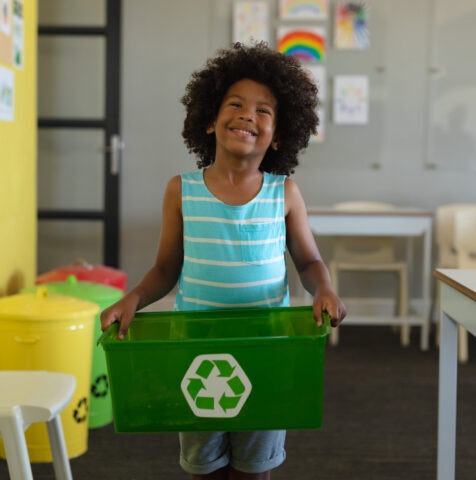IEL Resources
Tip Sheets
Tool Kits
Videos
Blogs
Podcasts

This list gives educators and family members resources on how to care for the environment by reducing, reusing, and recycling materials.
Tip Sheets
Tool Kits
Videos
Blogs
Podcasts
Every day, people make choices that affect the amount of trash and pollution that gets produced in the world. This article gives four steps to being green: 1) Reduce the amount of stuff used and thrown away. 2) Reuse stuff. 3) Recycle cans, bottles, paper, books, and even toys. 4) Enjoy the Earth.
This blog for teachers explains how preschool and kindergarten classrooms in one school engaged in a challenge to build trees with cardboard-like materials in an interactive way. Using recycled materials and previously learned skills like painting, gluing, and cutting, each class created their tree which turned out wonderfully unique based on their individual classroom focus.
These days many people are learning how to protect the environment and families will reduce the resources used, set a positive example, and help children learn how to help take care of the world.
This library guide offers online resources to help families green their home and make better environmental decisions with their family. Resources include YouTube videos, videos available from a local library, and children’s picture books.
For some time, only the most eco-centric teachers have attempted to use composting to teach science. But composting can be a rich source of project-based learning, with topics and activities to engage students at all levels.
This article geared for parents offers alternatives to traditional toys for children. There are many items parents dispose of every day that could be perfect toys for a young child. Parents can think about checking their recycling bin and introducing an item with the potential to be whatever their child imagines.
On April 22, people around the world celebrate Earth Day by planting trees, picking up litter, or heading outdoors to visit and celebrate natural spaces in communities. Protecting the planet shouldn’t be something done just one day a year. Raising environmentally-responsible kids is a way to be a good neighbor! Free online games, crafts, and printables are available on this page for children ages 2-5 and 6-8. Additional articles about earth day and caring for the environment are also linked for parents and children.
Reduce, Reuse, Recycle — Three great ways to eliminate waste and protect the environment! Waste, and how people choose to handle it, affects the world’s environment. This article, written for kids and their parents, explains what waste is and how kids can help be good caretakers of the environment.
In this article, Marc Jensen focuses on one aspect of environmental stewardship and sustainability: embracing solid waste reduction by reducing material consumption and by reusing and recycling used materials. These activities can make the abstract concepts of reducing, reusing, and recycling more concrete for young children, as they turn waste products back into attractive, meaningful objects and learn to see solid waste as a resource for creative reuse.
Gardening is naturally an activity that lends itself to reducing, re-using, and recycling. In any garden, the first goal needs to be to reduce what is used. Next, recycle, especially by composting as much plant material as possible. Finally, strive to find ways to reuse items that would otherwise be discarded.